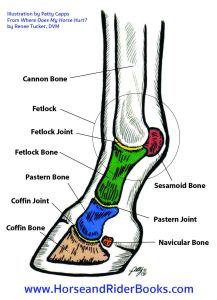In her bestselling book WHERE DOES MY HORSE HURT? Dr. Renee Tucker provides 27 simple body checkups you can do on your horse—a DIY method of determining when and where your horse hurts, and the best professional to call to help him feel better. Here’s how you might be able to pinpoint the cause of a subtle, “mystery,” or “phantom” lameness, and keep your horse actively and happily in work for more months of the year, and more years of his life.
BODY CHECKUP: THE SESAMOID BONES

Common behavioral or performance symptoms that might indicate a problem with the sesamoid bones:
Very Common
> Difficulty with fetlock flexion
Frequent
> Short-striding or “off” in front, possibly only on a circle
Occasional
> Reluctance to jump
> Going wide on barrel turns
> Difficulty with tight turns
> Difficulty with lateral movements
> Feet landing toe first
> Tripping
Common physical symptoms:
> A history of medial-to-lateral (right-to-left) hoof-wall imbalance
> Foot is “clubby” or has tendency to grow excess heel
What are the sesamoid bones?
The sesamoid bones function as part of the shock-absorbing mechanism of the front legs and are also a weight and power transition point. Because the sesamoid bones help transmit weight and power from the cannon bone to the fetlock and navicular bones in all directions, they need to be mobile in all directions. Their normal range of motion is most simply described as a circle. A sesamoid bone can move approximately one-eighth to one-quarter inch in each direction from its normal position.
Checkup directions:
1 Hold one of the horse’s feet up with the leg completely relaxed from the shoulder down. Cup the fetlock with both hands so that your thumbs rest on each side of the sesamoid bone being examined.
2 Gently slide the sesamoid bone in a circular manner, as if you were sliding it around the face of a clock. Do not use additional force if you encounter resistance in any area. The movement is very subtle. As mentioned, the normal range is from one-eighth to one-quarter inch. The key is in the smoothness of this movement. The sesamoid should slide easily along its path, rather than “sticking” or being more difficult to move in any section.

Diagnosis:
When there is any “stickiness” in the movement and the bone does not glide easily in all directions, it is most often a chiropractic subluxation. Be sure to check both right and left (medial and lateral) sesamoid bones on both front and rear legs. Compare the front and rear legs separately since front and rear sesamoid bones have different ranges of motion.
> When a subluxation is apparent, check the fetlock, pastern, coffin joint, and knee, since sesamoid bones rarely subluxate on their own, then call a chiropractor.
> When there is no movement in a sesamoid bone, call your veterinarian to X-ray for old fractures and/or calcification of ligaments.
> When the checkup is clear, yet symptoms remain, check for: hoof-wall imbalance; mineral or vitamin deficiency; arthritis in fetlock, knee, or coffin bone; or early tendon strain.

Get the complete set of Dr. Tucker’s Body Checkups in WHERE DOES MY HORSE HURT? available from the TSB online bookstore, where shipping in the US is FREE.
